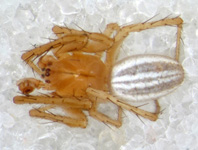Abstract
Ichneumonid wasps of the Polysphincta genus-group (Polysphinctini sensu Townes hereafter “polysphinctine wasps”) are exclusively koinobiont ectoparasitoids of spiders (Fitton et al. 1987; Gauld 2006). Since the first report of a spider’s behavior being manipulated by a polysphinctine wasp (Eberhard 2000), several studies have since focused on unravelling the mechanisms and evolution of this association (e.g. Gonzaga & Sobczak 2007; Matsumoto 2009; Sobczak et al. 2009; Eberhard 2010; Gonzaga & Sobczak 2011; Korenko & Pekár 2011; Korenko et al. 2013; Sobczak et al. 2014; Takasuka et al. 2015).
References
Agnarsson, I. (2006) A revision of the New World eximius lineage of Anelosimus (Araneae, Theridiidae) and a phylogenetic analysis using worldwide exemplars. Zoological Journal of the Linnean Society, 146, 453–593.
https://doi.org/10.1111/j.1096-3642.2006.00213.xDeyrup, M., Kraus, J. & Eisner, T. (2004) A Florida caterpillar and other arthropods inhabiting the webs of a subsocial spider (Lepidoptera: Pyralidae; Araneida: Theridiidae). Florida Entomologist, 87 (4), 554–558.
https://doi.org/10.1653/0015-4040(2004)087[0554:AFCAOA]2.0.CO;2Eberhard, W.G. (2000) Spider manipulation by a wasp larva. Nature, 406, 255–256.
https://doi.org/10.1038/35018636Eberhard, W.G. (2010) New types of behavioral manipulation of host spiders by a parasitoid wasp. Psyche, Article ID 950614, 1–4. https://doi.org/10.1155/2010/950614
Fitton, M.G., Shaw, M.R. & Austin, A.D. (1987) The Hymenoptera associated with spiders in Europe. Zoological Journal of the Linnean Society, 90, 65–93.
https://doi.org/10.1111/j.1096-3642.1987.tb01348.xGauld, I.D. (1991) The Ichneumonidae of Costa Rica. Vol. 1. Keys to subfamilies, and keys to the species of the lower pimpliform subfamilies Rhyssinae, Pimplinae, Poemeniinae, Acaenitinae and Cylloceriinae 1. Memoirs of the American Entomological Institute, 47, 1–589.
Gauld, I.D. & Dubois, J. (2006) Phylogeny of the Polysphincta group of genera (Hymenoptera: Ichneumonidae; Pimplinae): a taxonomic revision of spider ectoparasitoids. Systematic. Entomology, 31, 529–564.
https://doi.org/10.1111/j.1365-3113.2006.00334.x
Gonzaga, M.O. & Sobczak, J.F. (2007) Parasitoid-induced mortality of Araneus omnicolor (Araneae, Araneidae) by Hymenoepimecis sp. (Hymenoptera, Ichneumonidae) in southeastern Brazil. Naturwissenschaften, 94, 223–227.
https://doi.org/10.1007/s00114-006-0177-zGonzaga, M.O., Sobczak, J.F., Penteado-Dias, A.M. & Eberhard, W.G. (2010) Modification of Nephila clavipes (Araneae Nephilidae) webs induced by the parasitoids Hymenoepimecis bicolor and H. robertsae (Hymenoptera Ichneumonidae). Ethology Ecology & Evolution, 22, 151–165.
https://doi.org/10.1080/03949371003707836Gonzaga, M.O. & Sobczak, J.F. (2011) Behavioral manipulation of the orb-weaver spider Argiope argentata (Araneae: Araneidae) by Acrotaphus chedelae (Hymenoptera: Ichneumonidae). Entomological Science, 14 (2), 220–223.
https://doi.org/10.1111/j.1479-8298.2010.00436.xFritzen, N.R. (2014) Two new species of the Polysphincta genus-group (Hymenoptera: Ichneumonidae: Pimplinae) reared from their spider (Araneae) hosts in Europe. Zootaxa, 3894 (1), 117–130.
https://doi.org/10.11646/zootaxa.3894.1.9
Korenko, S. & Pekár, S. (2011) A Parasitoid Wasp Induces Overwintering Behaviour in Its Spider Host. PlosOne, 6 (9), e24628.
https://doi.org/10.1371/journal.pone.0024628
Korenko, S., Isaia, M., Satrapová, J. & Pekár, S. (2013) Parasitoid genus-specific manipulation of orb-web host spiders (Araneae, Araneidae). Entomological Science, 39 (1), 30–38.
https://doi.org/10.1111/een.12067
Matsumoto, R. (2009) “Veils” Against Predators: Modified Web Structure of a Host Spider Induced by an Ichneumonid Parasitoid, Brachyzapus nikkoensis (Uchida) (Hymenoptera). Journal of Insect Behavior, 22, 39–48.
https://doi.org/10.1007/s10905-008-9152-1
Matsumoto, R. & Takasuka, K. (2010) A revision of the genus Zatypota Förster of Japan, with description of nine new species and notes on their hosts (Hymenoptera: Ichneumonidae: Pimplinae). Zootaxa, 2522, 1–43.
Snodgrass, R.E. (1941) The male genitalia of Hymenoptera. Smithsonian Miscellaneous Collections, 99 (14), 1–86.
Sobczak, J.F., Lofrredo, A.P.S., Penteado-Dias, A.M. & Gonzaga, M.O. (2009) Two new species of Hymenoepimecis (Hymenoptera: Ichneumonidae: Pimplinae) with notes on their spider hosts and behaviour manipulation. Journal of Natural History, 43, 43–44.
https://doi.org/10.1080/00222930903244010Sobczak, J.F., Moura-Sobczak, J.C.M.S, Messas, Y.F., Souza, H.S. & Vasconcellos-Neto, J. (2014) A New Record of a Host-Parasitoid Interaction: Hymenoepimecis veranii Lofredo & Penteado-Dias, 2009 (Hymenoptera: Ichneumonidae) Parasitizing Araneus orgaos Levi, 1991 (Araneae: Araneidae). Journal of Insect Behavior, 27, 753–758.
https://doi.org/10.1007/s10905-014-9467-zTakasuka, K., Yasui, T., Ishigami, T., Nakata, K., Matsumoto, R., Ikeda, K. & Maeto, K. (2015) Host manipulation by an ichneumonid spider ectoparasitoid that takes advantage of preprogrammed web-building behaviour for its cocoon protection. Journal of Experimental Biology, 218, 2326–2332.
https://doi.org/10.1242/jeb.122739
Tanque, R.L., Kumagai, A.F. & Souza, B. (2010) Novos registros de espécies de Pimplinae e Rhyssinae (Hymenoptera, Ichneumonidae) no Brasil. Revista Brasileira de Zoociências, 12 (1), 103–106.
Yu, D.S., van-Achterberg, C. & Horstmann, K. (2012) Taxapad 2012. Ichneumonoidea 2011. Taxonomy, biology, morphology and distribution, available from: http://www.taxapad.com (accessed 3 November 2016)

